
Baltimore Recorders.org
About Harmonicas
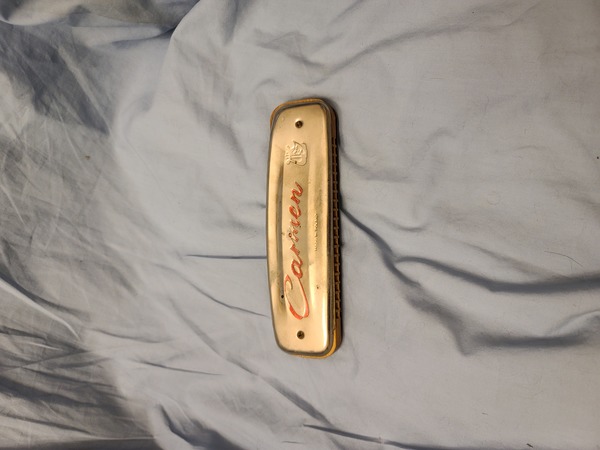
Harmonicas are single-reed wind instruments. Unlike the clarinet in which the vibration of the reed is controlled by the lips, the reeds in harmonicas are unimpeded, and are known as free reeds. They share this classification with accordions, and capped reeds such as the cornamuse. On one of the long sides of the instrument there is a row of holes, known as a comb. When you blow or draw air through a hole, it sets a metal reed in motion, producing a pitch. If you blow air through the hole, one pitch is produced, whereas if you suck or draw air through the same hole a different reed is activated and another pitch is produced. Typically, when you blow through the holes, the notes of a major triad will be produced. When you draw air through the holes, the other notes of the scale will be sounded Harmonicas are small, most not more than 4 inches long, making them eminently portable instruments.
Most harmonicas share the same basic type of construction. The top and bottom of the instrument are each covered with a plate. Traditionally these were made of metal and serve to protect the reeds. Sandwiched between the plates are two sheets of metal, traditionally brass. The reeds are riveted, bolted, welded or otherwise attached to the sheets. Between the plates for the reeds is the comb into which you blow. Originally these were made of wood, but are now sometimes made of plastic or metal.
There are many different types of harmonicas:
- Diatonic single-reed harmonicas
- Chromatic harmonicas
- Tremolo harmonicas
- Octave harmonicas
- Orchestra harmonicas
- Chord harmonicas
Diatonic single-reed instruments are the most common type of harmonica. They are known as diatonic instruments because the reeds are tuned to notes from a major scale, as opposed to other accidentals or chromatic notes. (This does not imply that accidentals cannot be played on diatonic instruments, as shall be explained below.) The typical diatonic instrument has a comb with 10 holes. The notes from the scale are not simply assigned to the holes in their order in the scale, c, d, e, f, g, etc... Rather there is a novel system of arranging the notes. This system is credited to a Mr. Richter, who lived during the nineteenth century. (He is also credited with inventing the blow / draw system.) He made an instrument called the Vamper, and thus the tuning system is sometimes called the Richter or Vamper tuning. The following chart illustrates Richter tuning:
| Hole number: | 1 | 2 | 3 | 4 | 5 | 6 | 7 | 8 | 9 | 10 |
| Blow note: | c | e | g | c | e | g | c | e | g | c |
| Draw note: | d | g | b | d | f | a | b | d | f | a |
As you can see the blow notes belong to a major triad, and the draw notes are the other notes from a major scale. It is possible to play non-diatonic notes on a harmonica. This is known as bending, and involves not blowing as hard, and changing the shape of the lips, known as the embouchure. For example, the g on the draw of the third hole can be bent down to f sharp or even down to f. Despite being able to bend, it is still most practical to play a harmonica in the key in which is it produced. Harmonicas are made in all 12 keys, and are sometimes sold in sets of 12.
Diatonic harmonicas are also produced with 12 holes, as well as with other tunings.
12 hole solo tuning:
| Hole number: | 1 | 2 | 3 | 4 | 5 | 6 | 7 | 8 | 9 | 10 | 11 | 12 |
| Blow note: | c | e | g | c | c | e | g | c | c | e | g | c |
| Draw note: | d | f | a | b | d | f | a | b | d | f | a | b |
Chromatic harmonicas were invented by the Hohner company in the early twentieth century. They have a single row of holes, like the diatonic instruments. However, they have two sets of reeds that are a half step apart, and thus have twice as many reeds as diatonic instruments. Only one set of reeds operates at a time. By pushing a knob of the side of the instrument, you can switch from one set of reeds to the other. Chromatic harmonicas typically have between 12 and 16 holes and use the solo tuning mentioned above.
Tremolo instruments have two rows of holes, rather than one. The rows are tuned roughly in unison, but with one reed tuned slightly higher than the other. This produces a tremolo, or shimmer to the sound. They are louder and project more than diatonic harmonicas as the two reeds produce more sound, and the slight difference in tuning between the reeds makes the sound more noticeable. Tremolo instruments are sometimes called Wiener harmonicas (after Vienna or Wien where they were first made), or double-reed harmonicas, as they have two reeds per pitch. It is important to note that they are still single-reed instruments and should not be confused with double-reed instruments such as the bassoon, oboe, or crumhorn.
Closely related to tremolo instruments are octave harmonicas. Like tremolo instruments, they have two rows of holes. One row is tuned an octave below the pitch of the other row.
Orchestra harmonicas are arranged more like a piano. One comb has the notes of a diatonic scale, with one note per hole; c, d, e, f, g, etc... Some models do not have draw notes, while others have draw notes that are identical in pitch to the blow notes. There is another comb that has the black keys of the piano. It is usually mounted on what appears to be a separate harmonica that is attached above the first. Some bass harmonicas such as Hohner's Bass 58 and Bass 78 are orchestra harmonicas.
Chord harmonicas are the least common type of harmonica. The largest instrument of this type is the Hohner Chord 48 and measures just short of 2 feet in length. It can play four part chords of many types including 7ths, augmented, and diminished chords.
A bit of history:
Free reed instruments, such as the crumhorn, have been in existence for hundreds of years. In China, the sheng used single reeds that were made of metal. In 1777, the sheng was introduced to Europe by Jean Joseph Marie Amiot, a Jesuit who had lived in China. This led to the development of various free reed instruments such as the accordion.
The invention of the harmonica is commonly credited to Christian Friedrich Ludwig Buschmann who lived from 1805 to 1864. There is a lack of sources to substantiate this belief. His father, Johann created a keyboard instrument called the uranion or terpodion, which was something like a glass harmonica. He traveled with his father selling, making, and repairing instruments. During the 1820s he created an instrument called the aura which had fifteen reeds, and looked something like a modern harmonica, complete with wooden comb and brass reeds.
Another early maker was Anton Reinlein of Vienna. He was originally a clockmaker by trade. He applied his skills in precision metalwork to the creation of musical instruments. There is an advertisement from 1828 for instruments made by Reinlein that include an extra long mouth blown harmonica with the range of two octaves.
By the middle of the nineteenth century, several craftsmen were involved in making harmonicas. These included Mr. Richter mentioned above, Christian Messner of Trossignen, Christian Weiss (Messner's younger nephew), Johann Christian Seydel and Christian August Seydel. In 1847, C. A. Seydel Co. was founded, and is the oldest company to produce harmonicas. They created a factory in Klingenthal, where their company is still headquartered. Matthias Hohner, who was a clockmaker like Reinlein, followed Seydel into business ten years later, in 1857. He operated out of Trossignen. Hohner quickly adopted methods of mass production. By 1879 Hohner produced 700,000 harmonicas.
The harmonica became popular in America. It was the perfect instrument to accompany people on their journeys. Soldiers carried them to battle, and settlers had them out west. Many well known historical figures are said to have played the harmonica, including Abraham Lincoln, Wyatt Earp, Billy the Kid, and Frank James. I have not found source documents that substantiate these claims.
During the twentieth century the instrument evolved. Combs began to be made from synthetic materials, such as ABS plastic rather than wood. Reeds began to be made from steel and plastic.
Harmonicas gradually worked their way into many aspects of American culture. DeFord Bailey and Gwen Foster played the instrument. Wally Schirra snuck a Hohner "Little Lady" harmonica on board the Gemeni VI mission. He played Jingle Bells and was accompanied by Tom Stafford on the bells. They were the first instruments to be played in outer space.
The harmonica was used in classical music. Ralph Vaughan Williams, Malcolm Arnold, Darius Milhaud, and Arthur Benjamin all wrote for the instrument.
Pictured here is a tremolo harmonica that has been in the family for decades. It is a Carmen model and is marked "Made in Poland". I believe that it dates from the 1960s.
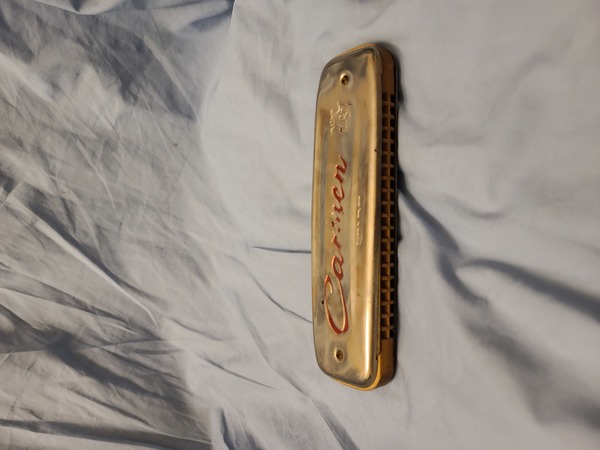
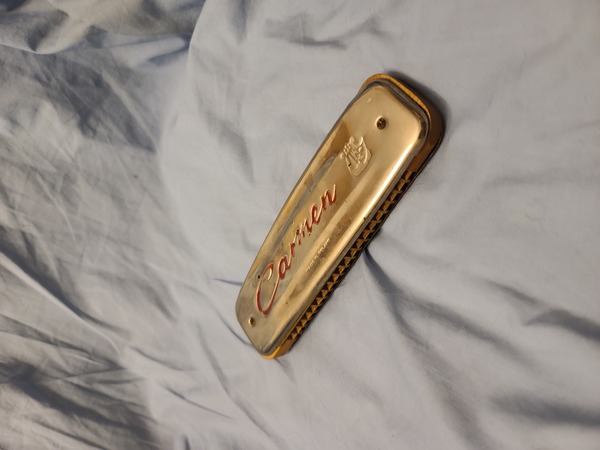
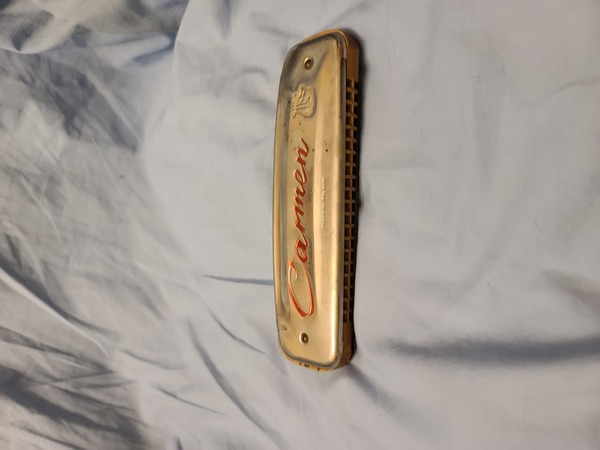
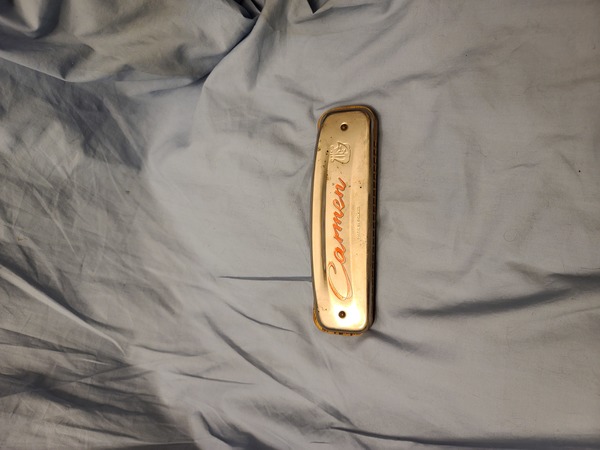
Web design copyright 2015 Michael Berger